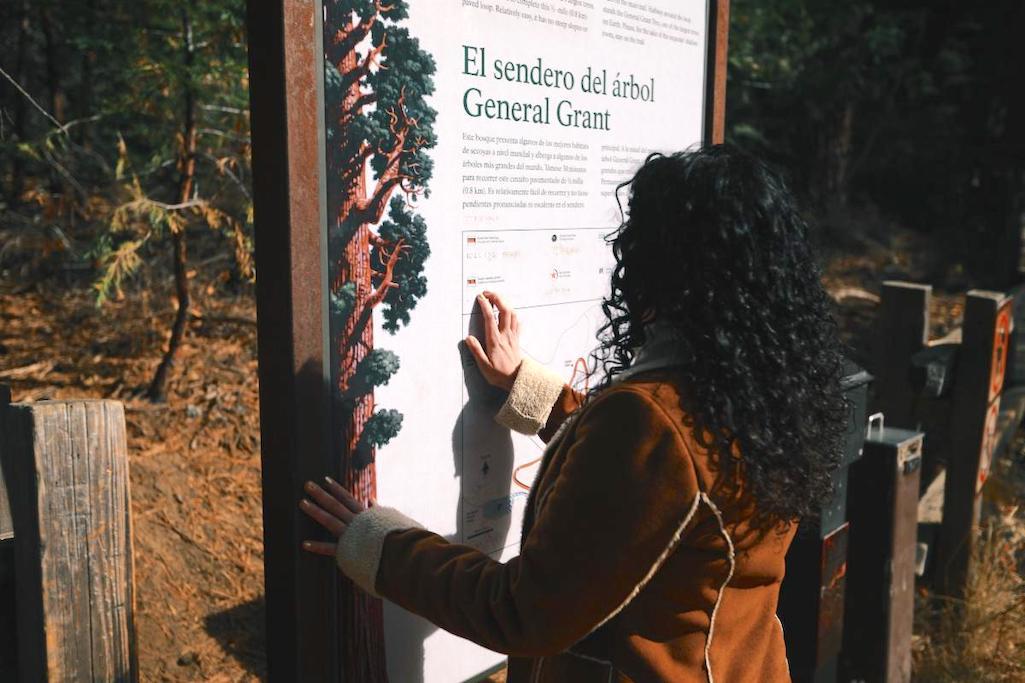
Sequoia and Kings Canyon national park staff are working on plans to make the two parks more accessible. This visitor is reading a sign that includes braille translation along the General Grant Tree Trail in Kings Canyon National Park/NPS file
Sequoia and Kings Canyon national parks can offer a demanding landscape if you require a wheelchair or other aid in getting around the park and its facilities or reading interpretive displays. Park staff realizes that, and is working on plans to improve access and interpretation to some of the parks' wonders.
If you've ever visited the two parks, you can appreciate the challenges. Exploring Giant Forest, visiting Crescent Meadow, peering into Tharp's Log, and climbing to the top of Moro Rock all are wonderful experiences, but can be challenging to those who need assistance.
In compiling an Accessibility Self-Evaluation and Transition plan for the two parks in California's Sierra Range, park staff tried to "1) document existing park barriers to accessibility for people with disabilities, 2) provide an effective approach for upgrading facilities, services, activities, and programs, and 3) instill a culture around creating universal access."
"Throughout the park, physical accessibility to services and facilities was generally found to be accessible. Accessible parking is provided at nearly all park areas, paths between accessible features are almost always paved and gently sloped, restrooms are large and maneuverable, and many interpretive waysides are in accessible locations," the draft document states. "Park staff has made a concerted effort to improve accessibility parkwide, with recent updates to some picnic areas, trailheads, and campgrounds.
"However, there remain barriers to accessibility at every park area that was assessed, some obstacles that would only inconvenience a person with a disability and others that would severely limit their ability to use services or see and participate in programs and activities."
Among the problem areas identified were:
- Too few or poorly dispersed accessible parking stalls.
- Some steeply sloped paths.
- Incorrectly installed or incorrectly placed elements in restrooms.
- Too few or inaccessible picnicking elements.
- A lack of appropriate accessible campsites.
- Devices throughout the park that were inoperable with a closed fist.
- Some interpretive panels and waysides, such as those at trailheads or on trails, were not located in accessible areas and were difficult to approach.
There also was a lack of parking for oversized vehicles, and shuttle vehicles needed to be made more accessible, among other things, according to the document.
Of course, it would be unrealistic to expect all areas of the two parks to be entirely accessible to everyone, and the park staff realizes that.
"Specific instances in which additional programmatic considerations would benefit the user experience include developing audio programs for popular visitor areas such as the General Sherman Tree Area or Grant Grove, developing audio description for exhibits at the Giant Forest Museum, and providing signage detailing trail conditions at all trailheads and on the park website," the document said. "For locations that are infeasible to make accessible, such as the viewing area at Moro Rock and petroglyphs at Hospital Rock, adding these locations to an audio program and providing photographs and video components at nearby accessible locations and visitor contact stations would make the information and views accessible to visitors unable to access these areas.
"Some experiences could be improved with minor changes such as by adding braille and tactile components to exhibits at the Giant Forest Museum or to waysides interpreting landmarks at the Crescent Meadow pulloffs," the document adds.
The end goal, the draft stated, is to "make it easier for individuals with cognitive, hearing, vision, and mobility disabilities to discover, understand, and enjoy the range of experiences available at the park."
You can find the entire report here. Public comment is being taken through August 27.



Add comment